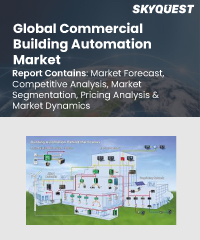
Report ID: SQMIG20C2062

Report ID:
SQMIG20C2062 |
Region:
Global |
Published Date: February, 2024
Pages:
157
|
Tables:
89 |
Figures:
76
Commercial Building Automation Market size was valued at USD 91.88 Billion in 2023 and is poised to grow from USD 101.16 Billion in 2024 to USD 218.44 Billion by 2032, growing at a CAGR of 10.1% during the forecast period (2025-2032).
The global commercial building automation market has been experiencing significant growth, driven by several key factors including increasing demand for energy-efficient solutions, advancements in Internet of Things (IoT) technology, and the growing emphasis on sustainable building practices. Building automation systems (BAS) play a crucial role in optimizing energy usage, enhancing occupant comfort, and streamlining building operations.
One of the primary drivers of market growth is the rising awareness among building owners and operators regarding the benefits of automation in reducing energy consumption and operational costs. With sustainability becoming a top priority for businesses worldwide, there's a growing adoption of BAS to monitor and control various building systems such as HVAC (heating, ventilation, and air conditioning), lighting, security, and access control.
These systems enable proactive management of energy usage through features like occupancy sensors, scheduling, and real-time monitoring, thereby contributing to cost savings and environmental conservation efforts.
Moreover, technological advancements in IoT and cloud computing have revolutionized the commercial building automation landscape. Integration of sensors, actuators, and other IoT devices into BAS enables remote monitoring and control of building systems from centralized platforms or mobile applications.
This connectivity facilitates data-driven decision-making, predictive maintenance, and optimization of building performance in real-time. Additionally, the emergence of smart building solutions, leveraging artificial intelligence (AI) and machine learning algorithms, further enhances the intelligence and autonomy of building automation systems, enabling adaptive and responsive control based on changing environmental conditions and occupancy patterns.
The commercial building automation market is characterized by intense competition and a rapidly evolving technological landscape. Key players in the industry are continually investing in research and development to innovate new solutions and stay ahead of the curve. Partnerships and collaborations between building automation companies and technology providers are also on the rise, fostering interoperability and the development of comprehensive solutions that meet the diverse needs of commercial building owners and operators.
Our industry expert will work with you to provide you with customized data in a short amount of time.
REQUEST FREE CUSTOMIZATIONWant to customize this report? This report can be personalized according to your needs. Our analysts and industry experts will work directly with you to understand your requirements and provide you with customized data in a short amount of time. We offer $1000 worth of FREE customization at the time of purchase.

Report ID: SQMIG20C2062